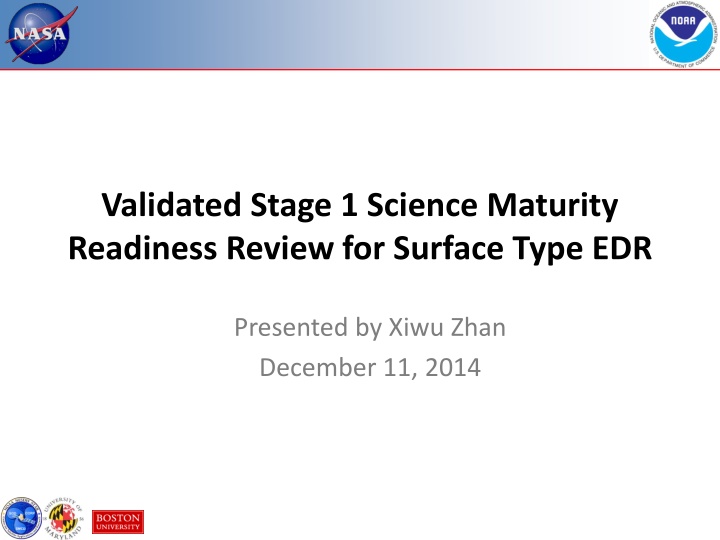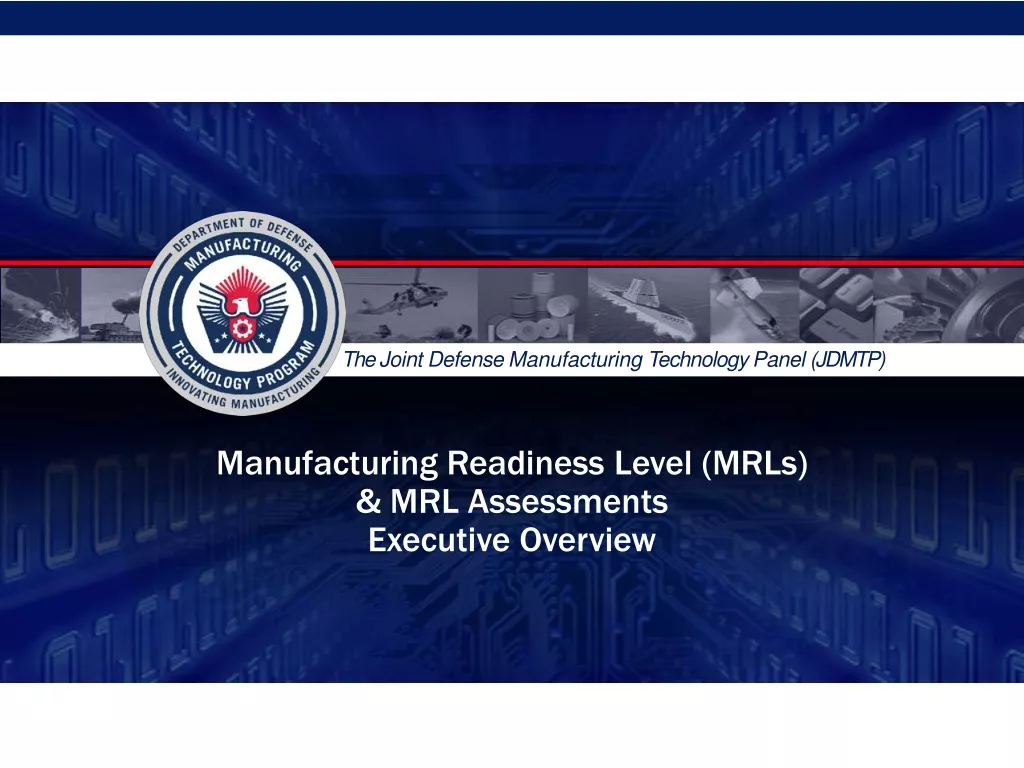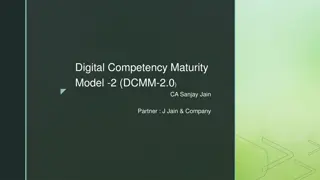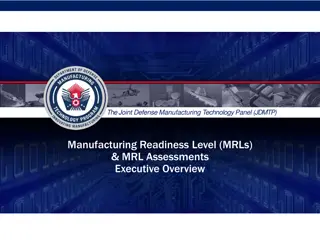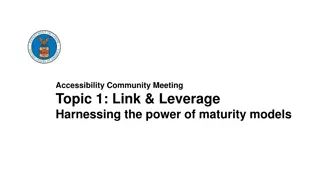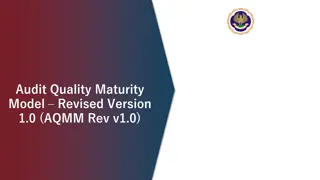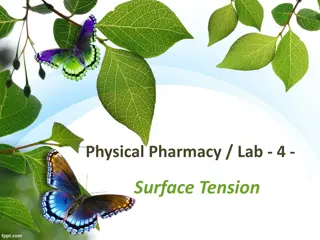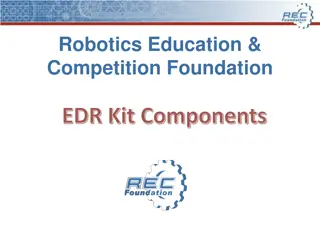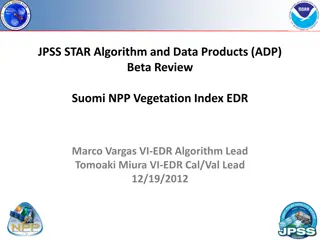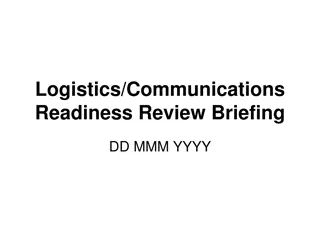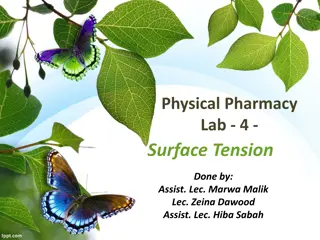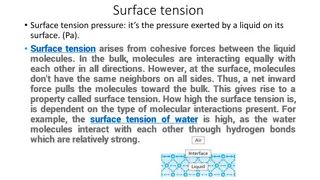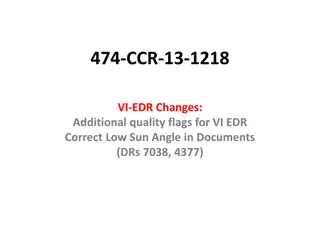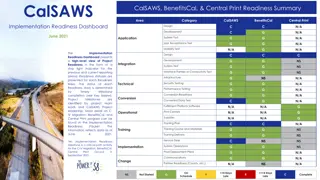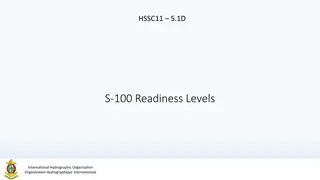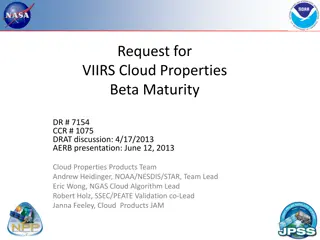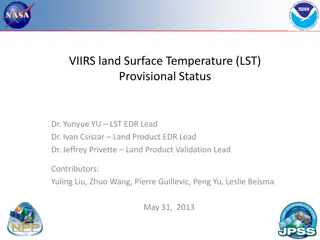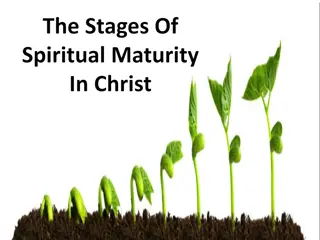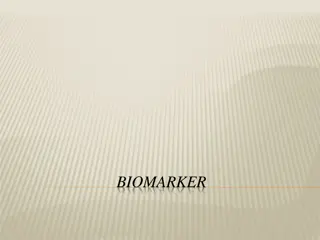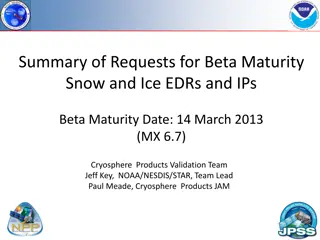Surface Type EDR Science Maturity Readiness Review
The Surface Type EDR team led by Xiwu Zhan presents a comprehensive review covering algorithm performance, user feedback, error budget, and more. Learn about the VIIRS surface type products and the global land/water mask data. The team members and their tasks are outlined in detail.
Download Presentation

Please find below an Image/Link to download the presentation.
The content on the website is provided AS IS for your information and personal use only. It may not be sold, licensed, or shared on other websites without obtaining consent from the author.If you encounter any issues during the download, it is possible that the publisher has removed the file from their server.
You are allowed to download the files provided on this website for personal or commercial use, subject to the condition that they are used lawfully. All files are the property of their respective owners.
The content on the website is provided AS IS for your information and personal use only. It may not be sold, licensed, or shared on other websites without obtaining consent from the author.
E N D
Presentation Transcript
Validated Stage 1 Science Maturity Readiness Review for Surface Type EDR Presented by Xiwu Zhan December 11, 2014 1
Outline Algorithm Cal/Val Team Members Product overview and requirements Previous validation results revisit Evaluation of algorithm performance to specification requirements Evaluation of the effect of required algorithm inputs Quality flag analysis/validation Error Budget Documentation Identification of Processing Environment Users & User Feedback Path Forward Summary 2
Surface Type EDR Cal/Val Team Name Organization Major Task Xiwu Zhan NOAA/STAR Surface Type EDR team lead, User outreach Chengquan Huang UMD/Geography Algorithm development lead Rui Zhang UMD/Geography Algorithm development, user readiness Mark Friedl BU/Geography Validation lead Damien Sulla- Menashe BU/Geography Ground truth data development and product validation Marina Tsidulko STAR/AIT Product delivery 3 3
Overview of VIIRS Surface Type EDR Describes surface condition at time of each VIIRS overpass Produced for every VIIRS swath/granule Same geometry as any VIIRS 750m granule Two major components Gridded Quarterly Surface Type (QST) IP Remapped to the swath/granule space for each VIIRS acquisition Requires at least one full year of VIIRS composited data Includes flags to indicate snow and fire based on Active fire Application Related Product (ARP/EDR) Snow EDR Vegetation Fraction is included, but is replaced with NDE GVF (By Marco Vargas) 4 4
VIIRS ST IP Overview Global surface type / land water mask product Gridded, 1km, 17 IGBP surface type classes. Required typing accuracy ~70% Generated annually to reflect recent changes Based on gridded surface reflectance products Use decision tree (C5.0) classifier, requires training data Global Surface Type IP with land water mask Global VIIRS Surface Type IP 5 5
VIIRS QST IP Overview Global surface type / land water mask product Gridded, 1km, 17 IGBP surface type classes. Required typing accuracy ~70% Generated annually to reflect recent changes Based on gridded surface reflectance products Use decision tree (C5.0) classifier, requires training data Water body Inland water VIIRS QST IP with land water mask Global VIIRS Quarterly Surface Type IP 6 6
Requirements ST EDR/QST IP Requirements from JPSS L1RD Attribute Threshold Objective Geographic coverage Global Global Vertical Coverage Vertical Cell Size N/A N/A Horizontal Cell Size 1 km at nadir 1 km at edge of scan Mapping Uncertainty 5 km 1 km Measurement Range 17 IGBP classes 17 IGBP classes Measurement Accuracy 70% correct for 17 types 70% correct for 17 types Measurement Precision 10% 10% Measurement Uncertainty 7 7
Current Status of Surface Type EDR Provisional maturity science review done in Jan 2014 1st VIIRS QST IP (gridded) based on pure VIIRS 2012 data was generated and reviewed in Jan 2014; Preliminary quality check indicates reasonable quality in Apr 2014 Provisional maturity AERB review done in Oct 2014 CCR-1653 approved: VIIRS ST EDR Veg Fraction fixes in May 2014; CCR-1700 approved: Improved VIIRS QST IP implemented in IDPS in Oct 2014; CCR-1700 verified: VIIRS ST EDR from Mx8.5 offline verified consistent with QST IP delivered from science team in Nov 2014 8 8
Previous Validation: VIIRS QST vs MODIS LC IGBP Legend MODIS The new VIIRS ST map compares favorably to the MODIS C5 (IDPS seed). 9 VIIRS 9
Previous Validation: 500 Validation Site Blocks BU has completed 290 of the 500 sample blocks (5km x 5km) (red points). 10 10
Previous Validation: Result 70% Accuracy Threshold BU s previous validation suggested that overall accuracies are similar between the MODIS seed and the new VIIRS ST-IP. 11 11
Data Product Maturity Definition Validated Stage 1: Using a limited set of samples, the algorithm output is shown to meet the threshold performance attributes identified in the JPSS Level 1 Requirements Supplement with the exception of the S-NPP Performance Exclusions 12 12
Evaluation of algorithm performance to specification requirements Findings/Issues from Provisional Review Confusions among croplands, cropland/natural vegetation mosaics, and other similar vegetative type, such as grasslands, savannas, and open shrublands MODIS LC VIIRS ST 13 13
Evaluation of algorithm performance to specification requirements Findings/Issues from Provisional Review Confusions among croplands, cropland/natural vegetation mosaics, and other similar vegetative type, such as grasslands, savannas, and open shrublands MODIS LC VIIRS ST 14 14 Not pure cropland, but mosaic
Evaluation of algorithm performance to specification requirements Improvements since Provisional Algorithm Improvements: post-classification modeling for croplands. An four land cover (GLC2000, GLC, MODIS LC, UMD LC) agreement data set is used as reference to improve croplands class. Improved QSTIP (post- classification modeling) MODIS-based Seed Initial QST IP (April 14) 15 15
Evaluation of algorithm performance to specification requirements Cal/Val Activities for evaluating algorithm performance: Validation strategy / method Additional validation after Provisional Confusion matrices and total accuracy are used to assess the classification performances. Reference data derived through visual interpretation of high resolution satellite images. Google Map Google Earth Other existing surface type products for references Developed an integrated GUI tool to improve visual interpretation efficiency 16 16
Evaluation of algorithm performance to specification requirements Cal/Val Activities for evaluating algorithm performance: Test / ground truth data sets 5000 validation pixels were selected globally using stratified random sampling strategy (Olofsson et al., 2012 in IJRS), the same method with previous validations conducted by BU. - - Stratified random sampling More emphasis on - Important classes - Classes affected by human activities - Rare classes 17 17
Evaluation of algorithm performance to specification requirements Cal/Val Activities for evaluating algorithm performance: Test / ground truth data sets Integrated validation GUI tool developed. 2. Ground photo from Google Earth can be used to improve interpretation confidence. 1. Automatically load in Google map high resolution image for each reference point (1km) 18 18
Evaluation of algorithm performance to specification requirements Cal/Val Activities for evaluating algorithm performance: Validation results Overall accuracy: 73.92% (required 70%) Confusion Matrix (in percent): ENL EBL DNL DBL Mix C. Shurb O. Shurb Woody 0 0 0.9 0 0 62.16 15.32 5.41 4.5 9.91 0 0.9 0 0.9 0 0 Sav Grass Wet Crop Urban Crop mos Snow/Ice Barren 0 0.73 0 0.73 1.95 0.97 2.19 7.3 3.41 3.41 0 15.57 0.97 62.77 0 0 ENL EBL DNL DBL Mix C. Shrub O. Shurb Woody Sav Grass Wet Crop Urban Crop mos Snow/Ice Barren 85.98 0 3.85 1.43 1.9 10.74 3.7 2.59 2.59 66.3 0.37 1.48 6.3 0.74 1.11 1.48 0.74 0.2 3.4 4.29 1.61 2.15 6.44 0.36 0.89 64.04 4.83 2.33 0.36 0.89 0.36 8.05 1.12 2.8 0.28 2.52 1.68 0.84 0.84 15.69 47.9 5.88 1.12 5.32 0.28 13.73 0.18 2.38 0.13 0.13 0 0 0 0 0 0 0 0 0 0 0 0 0 0 0 0 0 0 0 0 0 0 0 0 0 94.09 0 0 0 0 0 0 0 0 0 0 0 0 2.44 0 0 71.15 0.96 17.31 0 0 0 0 55.24 22.38 1.43 0.48 9.05 0.48 1.9 0.48 1.9 0.36 0.36 4.88 0.61 1.22 3.05 0.61 0.13 0.13 1.73 1.33 0.66 6.12 0.13 83.38 1.33 4.65 1.02 0 0 0 0 1.81 80.89 1.21 1.41 10.06 0.8 1.01 0.2 1.81 0 0 9.79 1.42 1.42 72.06 0.36 9.07 0.18 4.27 9.52 2.38 1.02 2.04 1.02 2.04 8.42 2.24 0.61 4.81 0 0 0 0 0 0 0 0 0.61 0.61 0.61 0 0 0 5.26 80.95 4.76 0 0 0 0.96 8.16 81.63 3.06 0 0 0 0 0.2 2.24 0 0 0 0 0 0 0 0.35 0.35 0.96 3.33 1.85 0 0 0 0 0 0 0 0 0 0 0 0 0 0 0 0 0 100 0 0.6 0.53 0.13 0 85.61 19 19
Evaluation of algorithm performance to specification requirements Cal/Val Activities for evaluating algorithm performance: Validation results Producer s accuracy and user s accuracy 20 20
Evaluation of the effect of required algorithm inputs Required Algorithm Inputs for QST-IP Primary Sensor Data TOA reflectance or surface reflectance data Ancillary Data Training samples from BU and agreement dataset (both from non VIIRS sources) Upstream algorithms Snow Cover EDR, Active Fire, Cloud Mask, TOC NDVI LUTs / PCTs EDR processing coefficients 21 21
Evaluation of the effect of required algorithm inputs Evaluation of the effect of required algorithm inputs Individual VIIRS acquisitions very noisy Cloud/cloud shadow Multi-stage compositing to remove/reduce cloud/shadow contamination Cloud/shadow greatly reduced in 32-day and annual composites Classification by pattern classifiers has high tolerance on residual bad data in the annual metrics Other upstream EDR inputs look normal based on examinations of the quality flags 22 22
Evaluation of the effect of required algorithm inputs Evaluation of the effect of required algorithm inputs Only is QST-IP generation required reflectance data evaluated. A series of gridding, compositing and metrics calculation were performed in processing required reflectance input data, quality of individual reflectance has minimum impact on final annual metrics. The procedure is designed to filter out all kinds of noises, such as cloud and anomaly data, therefore, the algorithm has relatively high tolerance to negative effects of input data errors as long as their spectral resolutions are satisfactory. 23 23
Evaluation of the effect of required algorithm inputs Evaluation of the effect of required algorithm inputs Study / test cases Daily (2012/200) Cloud reduction through composting 8day (2012/193-200) 32day (2012/193-2224) 24 24
Evaluation of the effect of required algorithm inputs Noises reduced further in annual metrics 2012 Median NDVI Median of the Three Warmest 32-day Composites 25 25
Quality flag analysis/validation Defined Quality Flags (ST EDR) 26 26
Quality flag analysis/validation Comparison of Fire ARP and Fire QC flag in ST EDR ST EDR Swath, 750 m @ nadir Fire pixels has value of 1 in QC flag From LPEATE s IDPS copy Fire ARP Vector format showing location of fire pixels, no imagery product From LPEATE s IDPS copy Data preparation for comparison Convert Fire ARP vector file to imagery product (used in the following comparison) Compare Fire ARP with fire flag in ST EDR 27
Quality flag analysis/validation Granule Fire Pixel Counts Identical in ST EDR and Fire EDR All Granules Acquired on 12/31/2012 All Granules Acquired on 02/05/2013 Comparison of Granule-Level Fire Pixel Count Comparison of Granule-Level Fire Pixel Count 7000 7000 6000 6000 Number of Fire Pixels in Fire EDR Number of Fire Pixel in Fire EDR 5000 5000 4000 4000 3000 3000 2000 2000 1000 1000 0 0 0 1000 2000 3000 4000 5000 6000 7000 0 1000 2000 3000 4000 5000 6000 7000 Number of Fire Pixel in ST EDR Number of Fire Pixels in ST EDR Each point represent one VIIRS granule 28
Quality flag analysis/validation Zoom-in Comparison of Fire Flags Fire ARP Fire Flag in ST EDR Algeria Acquired @ 23:55 on 02/05/2013 Legend Fire Non-fire El Salvador Acquired @ 18:05 on 02/05/2013 29
Quality flag analysis/validation Zoom-in Comparison of Fire Flags Fire ARP Fire Flag in ST EDR Nigeria Acquired @ 12:35 on 12/31/2012 Legend Fire Non-fire Scandinavia Acquired @ 11:20 on 02/05/2013 30
Quality flag analysis/validation Comparison of Snow EDR and Snow QC flag in ST EDR ST EDR Swath, 750 m @ nadir Snow pixels has value of 1 in QC flag From LPEATE s IDPS copy Snow EDR Swath, 375 m @ nadir From LPEATE s IDPS copy Data processing for comparison Every 2 x 2 snow EDR pixels aggregated to match ST EDR pixels If > 2 pixels in the 2x2 snow EDR window are snow, flag snow in the ST EDR To avoid impact of resampling, comparison made in swath space 31
Quality flag analysis/validation Granule-Level Snow Pixel Counts Near Identical in ST EDR and Snow EDR All Granules Acquired on 12/31/2012 All Granules Acquired on 02/05/2013 Comparison of Granule-Level Snow Pixel Count Comparison of Granule-Level Snow Pixel Count 6000000 6000000 5000000 5000000 Number of Snow Pixel in Snow EDR Number of Snow Pixel in Snow EDR 4000000 4000000 3000000 3000000 2000000 2000000 1000000 1000000 0 0 0 1000000 2000000 3000000 4000000 5000000 6000000 0 1000000 2000000 3000000 4000000 5000000 6000000 Number of Snow Pixel in ST EDR Number of Snow Pixel in ST EDR Each point represent one VIIRS granule 32
Quality flag analysis/validation Detailed Comparison of Snow Flags in ST EDR and VIIRS Snow EDR Snow in Snow EDR Snow in ST EDR North Antarctica Acquired @ 08:50 on 12/31/2012 Legend Snow Non-snow Eastern Siberia Acquired @ 21:15 on 12/31/2012 33
Quality flag analysis/validation More Comparison of Snow Flags in ST EDR and VIIRS Snow EDR Snow in Snow EDR Snow in ST EDR North of Baikal Russia Acquired @ 04:45 on 02/05/2013 Legend Snow Non-snow North Spain Acquired @ 13:10 on 02/05/2013 34
Quality flag analysis/validation Quality flag analysis/validation: CCR-1264 approved in Oct 2013 Use IVSIC when Snow EDR not available Baseline Surface Type output: QF1, bit1: Snow (yellow) updated with SnowFraction EDR Proposed Surface Type output: QF1, bit1: Snow (yellow) updated with GIP Snow (IVSIC) Proposed Surface Type output: QF2, bit4: Snow source: 0 (white) - SnowFraction EDR; 1(blue) - GIP Snow (IVSIC) GIP Snow (IVSIC) (blue) 35 35
Error Budget Compare analysis/validation results against requirements, present as a table. Error budget limitations should be explained. Describe prospects for overcoming error budget limitations with future improvement of the algorithm, test data, and error analysis methodology. Attribute Analyzed L1RD Threshold Analysis/Validation Result Error Summary Surface type classification accuracy 70% 73.92% meets the L1RD threshold spec 36 36
Documentation The following documents will be updated and provided to the EDR Review Board before AERB approval: ATBD latest update Jan 29th, 2014 OAD last update Apr 30th, 2014 README file for CLASS provided in Nov, 2014 Product User s Guide (Recommended): document standard to be provided 37 37
Identification of Processing Environment IDPS or NDE build (version) number and effective date Mx8.5, Nov. 14, 2014 Algorithm version 1.O.000.004 Version of LUTs used NA Version of PCTs used NA Description of environment used to achieve validated stage 1 Mx8.5 38 38
Identification of Processing Environment VIIRS surface type EDR is produced in IDPS VIIRS QST IP: It is an ancillary data layer (tiles) for VIIRS surface type EDR Its production requires at least one whole year VIIRS gridded composited data of VI, BT and surface reflectance MODIS experience proved that it could not be reliably and practically generated every three months It will be generated once a year at science computing facility (STAR/University of Maryland) and delivered to IDPS by Algorithm Integration Team 39 39
Users & User Feedback User list Modeling studies Land surface parameterization for GCMs Biogeochemical cycles Hydrological processes Carbon and ecosystem studies Carbon stock, fluxes Biodiversity Feedback from users(Primary user: NCEP land team led by M. Ek) Downstream product list Land surface temperature (direct) Cloud mask, aerosol products, other products require global land/water location information (indirect) Reports from downstream product teams on the dependencies and impacts No significant impacts reported from LST and VCM team 40 40
Path Forward Planned further improvements of QST IP Better compositing algorithm Use multiple year data More training data with better representative SVM classification will replace C5.0 decision tree classification Post-classification improvements Name may be revised to Global Surface Type Potential improvement for ST EDR: To include flags for standing water, burned area in addition to active fire and snow To be used as an surface type change product as well as down stream product input 41 41
Path Forward Planned Cal/Val activities / milestones Validate SVM generated surface type EDR Improve validation tool for next phase validation and long term monitoring Develop quality flag monitoring tools 42 42
Summary Surface Type EDR/QST IP Validation: Overall accuracy from the new validation effort suggested that the classification accuracy on surface type intermediate product meets the required 70% correct rate. Quality flags verified, no errors found. Team recommends algorithm validated stage 1 maturity 43 43
Thanks! 44 44
Backup slides 45 45
Quality flag analysis/validation Quality flag analysis/validation: example Vegetation, validation successful Extracted vegetation quality flag from VSTYO_npp_d20141118_t2000204_e2001446_b15 854_c20141119022854205831_noaa_ops.h5 Nov. 18, 2014, M7, M5, M3 Composite over Texas/Louisiana area, USA 46 46
Quality flag analysis/validation Quality flag analysis/validation: example Cloud cover, validation successful Extracted cloud cover quality flag from VSTYO_npp_d20141118_t2000204_e2001446_b15 854_c20141119022854205831_noaa_ops.h5 Nov. 18, 2014, M3, M5, M7 Composite over Texas/Louisiana area, USA 47 47
Quality flag analysis/validation Quality flag analysis/validation Analysis/validation results Comparisons and analyses suggested all quality flags in documents have been implemented successfully in the ST-EDR, and no errors were found. Analysis/validation plan for next validated stages Quality flag monitoring tools will be developed to automatically check the flags. Input data quality will be evaluated. 48 48
Identification of Processing Environment Mx8.5 ST data verification Compare the operational produced ST EDR data with science team delivered ST IP data, should be identical ST data from Mx8.5 ST-EDR. Nov. 16, 2014 North America Delivered VIIRS ST-IP Comparisons suggest the delivered VIIRS based ST-IP has been implemented in Mx8.5 49 49
